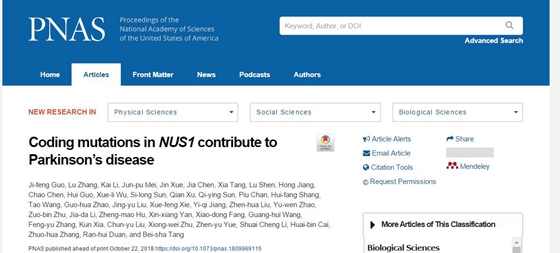On October 23, the internationally renowned academic journalProceedings of the National Academy of Sciences of the United States of America(PNAS) published the latest research in the field of Parkinson's disease from the team of Professor Tang Beisha, which is from the Department of Neurology, Xiangya Hospital of Central South University, the National Institute of Geriatrics and Clinical Medicine, and the Medical Genetics Research Center of Central South University. The team's member, Guo Jifeng, a deputy chief physician, said that they used a denovo mutation analysis strategy combined with next-generation sequencing technology to identify a new PD risk gene, NUS1, in Parkinson's disease (PD) in China. The study entitledCoding mutations in NUS1 contribute to Parkinson’s disease, was published online, with Professor Tang Beisha as the corresponding author, and Guo Jifeng and Dr. Zhang Lu from Stanford University as the co-first authors.

The etiology and pathogenesis of PD are still not very clear. It is now believed that aging, genetics and environmental factors and their interactions are involved in the development of PD. Since the identification of the first PD-causing gene, SNCA, in the 1990s, the role of genetic factors in the pathogenesis of PD has received increasing attention. Professor Tang Beisha's team first analyzed the core family of 39 early onset Parkinson's disease (EOPD) using Whole Exome Sequencing (WES) technology, and screened 12 new candidate genes; two stages of validation were followed: in the first stage, in 1852 patients with PD and 1565 normal controls in China, the frequency distribution of rare variants of NUS1 gene was statistically significant (P=0.03); at the second stage, a validation was performed in a multicenter cohort involving 3237 patients with PD and 2858 normal controls. It was found that PD patients carried more rare mutations in the NUS1 gene (P=1.01×10-5, OR=11.3); and carriers with NUS1 genetic variants all showed typical clinical symptoms of PD. In addition, it was found that the C.691+3dupA mutation of the NUS1 gene caused a change in the splice site, resulting in a loss of function; in the NUS1 gene knockdown Drosophila model, reduced movement, loss of dopaminergic neurons, and decreased dopamine transmitter were observed. These findings suggest that the NUS1 gene may play a role in the development of PD. This is the first time that PD new risk genes have been identified in the Chinese PD population, and a new idea of PD development has been proposed. Its clinical significance is to help early warning, early diagnosis and early intervention of PD.
Professor Tang Beisha's team has been working on the localization and cloning of pathogenic genes in neurodegenerative diseases and neurogenetic diseases. As early as in the 1990s, Professor Tang Beisha participated in the research on the first pathogenic gene cloned by the Xia Jiahui academician team in China, which is the human neurogenic high-frequency deafness gene-GJB3 gene. In recent years, the team has innovatively proposed the "LEC" and "HEC" gene cloning strategies, successfully identified the cloned SCA35 pathogenic gene TGM6, ARCA pathogenic genes CHIP and UBA5, CMT pathogenic gene HSP22, PKD pathogenic gene PRRT2 and FCMTE pathogenic gene SAMD12, etc., and systematically established a genetic diagnosis and analysis platform for high-throughput sequencing technology of nervous system genetic diseases. In the field of PD, the team focused on PD genomics research, screening and identification of new PD genes and novel susceptibility genes, and proposed "two-gene inheritance mode in PD", "PLA2G6 new mutation-new phenotype (AREP)", "PD risk gene SNPs interaction mode (PD-LRRK2G2385R+) and additive mode of action (PD-risk gene SNPs+)".
Source: Xiangya Hospital











